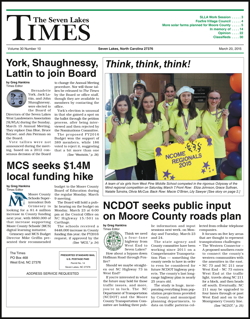 Taking a key step to advance its long-anticipated major repaving project, the Seven Lakes Landowners Association [SLLA] Board of Directors has awarded a $12,500 contract to engineering firm S&ME, which will inspect, evaluate, and develop specifications for the eventual repair and resurfacing of the twenty-seven miles of roads in Seven Lakes North and South.
Taking a key step to advance its long-anticipated major repaving project, the Seven Lakes Landowners Association [SLLA] Board of Directors has awarded a $12,500 contract to engineering firm S&ME, which will inspect, evaluate, and develop specifications for the eventual repair and resurfacing of the twenty-seven miles of roads in Seven Lakes North and South.
Recommended by Director Bud Shaver last April, the engineering firm's report will help the Board prioritize areas for repaving -- as well as help determine whether the overall project should be done in incremental phases, as funding allows, or all at once, using borrowed money.
During discussion at the Wednesday, October 26 SLLA Open Meeting, Director Bob Racine noted the engineering contract did not include a provision to confirm actual road mileage.
“I am concerned the contract is relying on distances estimated by Bud [Shaver], which he had recommended should be rechecked,” said Racine. “I suggest we table the contract until we get some clarification from them.”
Director Shaver also suggested the contract should include a request that S&ME inspect the roadways after a heavy rain, to better evaluate those areas with existing water drainage problems.
However, anxious to get the long-delayed project started, the majority of Directors agreed that the contract was adequate as written. After a motion to postpone the decision failed to win a majority, the S&ME engineering contract was approved on a 5-2 split vote, with Racine and Director Bruce Keyser, Jr. opposed.
 The absence of two members — Jimmy Melton and Larry Caddell -- from the Moore County Board of Commissioners' Tuesday, November 2 meeting resulted in the tabling of many, if not most, items on the meeting agenda.
The absence of two members — Jimmy Melton and Larry Caddell -- from the Moore County Board of Commissioners' Tuesday, November 2 meeting resulted in the tabling of many, if not most, items on the meeting agenda. Though the fix may be temporary, the Foxfire Village Council reapproved on Tuesday night, October 11, an ordinance amendment originally drafted and approved in 2005 that increased the minimum lot size for equestrian district zoning from six to ten acres.
Though the fix may be temporary, the Foxfire Village Council reapproved on Tuesday night, October 11, an ordinance amendment originally drafted and approved in 2005 that increased the minimum lot size for equestrian district zoning from six to ten acres. Finding a replacement for retiring Superintendent Dr. Susan Purser by year's end is a top priority for the Moore County Board of Education, which recently fielded online surveys to gather input from both the community and Moore County Schools [MCS] staffers.
Finding a replacement for retiring Superintendent Dr. Susan Purser by year's end is a top priority for the Moore County Board of Education, which recently fielded online surveys to gather input from both the community and Moore County Schools [MCS] staffers.